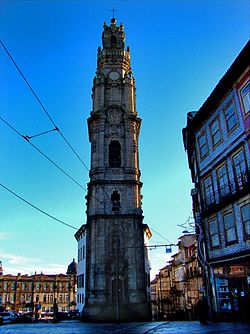- Clérigos Church
-
Coordinates: 41°08′44″N 8°36′53″W / 41.14556°N 8.61472°W
The Clérigos Church (Portuguese: Igreja dos Clérigos, pronounced: [ˈklɛɾiɡuʃ]; "Church of the Clergy") is a Baroque church in the city of Porto, in Portugal. Its tall bell tower, the Torre dos Clérigos, can be seen from various points of the city and is one of its most characteristic symbols.
The church was built for the Brotherhood of the Clérigos (Clergy) by Nicolau Nasoni, an Italian architect and painter who left an extense work in the north of Portugal during the 18th century.
Construction of the church began in 1732 and was finished around 1750, while the monumental divided stairway in front of the church was completed in the 1750s. The main façade of the church is heavily decorated with baroque motifs (such as garlands and shells) and an indented broken pediment. This was based on an early 17th century Roman scheme. The central frieze above the windows present symbols of worship and an incense boat. The lateral façades reveal the almost elliptic floorplan of the church nave.
The Clérigos Church was one of the first baroque churches in Portugal to adopt a typical baroque elliptic floorplan. The altarpiece of the main chapel, made of polychromed marble, was executed by Manuel dos Santos Porto.
The monumental tower of the church, located at the back of the building, was only built between 1754 and 1763. The baroque decoration here also shows influence from the Roman Baroque, while the whole design was inspired by Tuscan campaniles. The tower is 75.6 metres high, dominating the city. There are 225 steps to be climbed to reach the top of its six floors. This great structure has become the symbol of the city.
In Oporto, Nicolau Nasoni was also responsible for the construction of the Misericórida Church, the Archbishop's Palace and the lateral loggia of Oporto Cathedral. He entered the Clérigos Brotherhood and was buried, at his request, in the crypt of the Clérigos Church.
References
- Portuguese Institute for Architectural Heritage [1]
Categories:- Churches in Porto
- Towers in Portugal
- 1750 architecture
- Campaniles
- Baroque architecture in Portugal
- National monuments in Portugal
Wikimedia Foundation. 2010.


